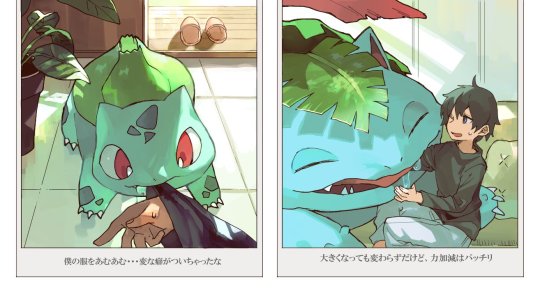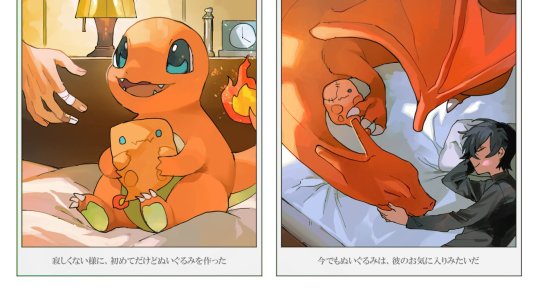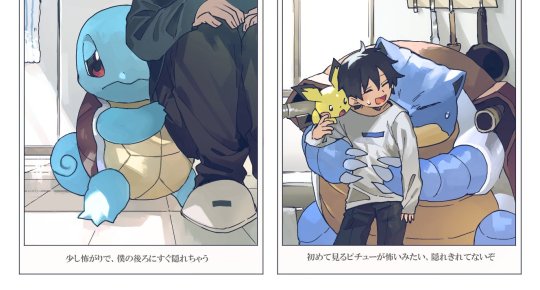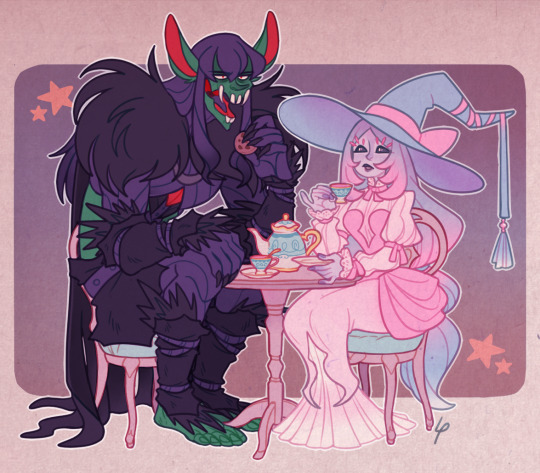A blog to compile general Pokemon stuff I like. Occasionally I'll chronicle runs through the various games or write in-universe drabbles/worldbuilding/fanfiction
Don't wanna be here? Send us removal request.
Text
"Invasive" Pokemon: Giant Hogweed Meganium
“Giant Hogweed” Meganium
The Herb Pokemon
Type: Grass/Poison
Height: 8′9″
Weight: 450 lbs
Ability: Phototoxin
Egg Group: Monster/Grass
Fully evolved, this Meganium variant now towers over its holotype. Aside from the features of its pre-evolutions, the ruffe around its neck has how erupted in a great mane of delicate white flowers. This floral display and its haughty attitude has given it the nickname "The Noxious Noble". The antennae on its head are stiff and hard, but far from immobile. These small appendages are often drummed against the neck to communicate with others of its kind. The hind legs have now fully fused into one giant taproot, turning this once quadropedal Pokemon into a tripod.
This Meganium rules its territory like a despotic lord, only ever tolerating Chikorita and Bayleef of its own kind. Any other Grass-type that enters its territory is immediately chased off with a toxic torrent. This Pokemon seldom moves, often delegating the duties of defense to the pre-evolutions it lords over, commanding them with the antennae drumming against its neck that can be heard for miles. When it is roused to anger, usually when threatened by another fully evolved Grass-type, it will awkwardly gallop towards the threat before unleashing a wave of phototoxic fumes, hairs, and sap from all over its body. Though beautiful to look at, this Pokemon is banned from most regions due to its aggressive nature and its ability to take over large swaths of territory.
#pokemon#invasive pokemon#fakemon#pokemon variants#meganium#triffid#triffids#invasive species#giant hogweed
5 notes
·
View notes
Text
"Invasive" Pokemon: Giant Hogweed Bayleef
“Giant Hogweed” Bayleef
The Leaf Pokemon
Type: Grass/Poison
Height: 5′9″
Weight: 75 lbs
Ability: Phototoxin
Egg Group: Monster/Grass
Much like its previous evolution, this Bayleef variant carries deep grooves along its body, a dark green hue, purplish spots, a deeply lobed head leaf, and a ruffe of white hairs around the base of its neck. Its hind legs are beginning to fuse into a single taproot, which results in an awkward gait when walking. Twisted, dark green buds are beginning to sprout from the ruffe around its neck. These buds secrete an irritating vapor that burns the eyes and lungs of living things that get too near to it, unlike the spicy sweet smell of the holotype.
Though the fused hind legs of this variant make it more difficult to move, this Bayleef makes up for that fact with even more potent defenses. Its sap can now be spewed from its mouth in spouts, causing blisters and horrible scars on anything it touches, especially if the victim is in bright sunlight. It is said even the ruffe around its neck can be an irritant, causing rashes on even the briefest of contact. With its improved taproot, this Pokemon can weather even the harshest winters or longest droughts, staying green and healthy when most other Grass-types would wither or migrate.
#pokemon#invasive pokemon#invasive species#giant hogweed#bayleef#fakemon#pokemon variant#triffid#triffids
1 note
·
View note
Text
“Invasive” Pokemon: Giant Hogweed Chikorita
“Giant Hogweed” Chikorita
The Leaf Pokemon
Type: Grass/Poison
Height: 3′5″
Weight: 18 lbs
Ability: Phototoxin
Egg Group: Monster/Grass
This variant of the Chikorita species hails from a cold, mountainous region of the world. While familiar at first glance, at least compared to its evolutions, the differences increase on closer inspection. The Hogweed Chikorita’s skin is overall a darker green, with a multitude of purplish splotches across the body, as unique as a fingerprint. Faint striations line the body, especially along the head and neck. The leaf atop its head is finely toothed and deeply lobed, almost resembling a maple leaf. The seeds around its neck are largely concealed by a ruffe of white hairs. Its stubby legs double as woody taproots, sacrificing mobility for storing nutrients and being able to root in place. Finally, this variant of Chikorita is much larger and heavier than its Johtoian counterpart.
While striking and beautiful in its own way, this Pokemon is extremely dangerous. Since it cannot move with the same ease as its holotype, it has developed potent defensive measures to defend itself. The sap it secretes from its leaf seems harmless at first, but turns toxic and irritating once exposed to sunlight. This empowers its ability, Phototoxin, which powers up Poison-type moves on a sunny day. When this Pokemon takes root, its sturdy roots and stubborn nature make it very difficult to remove.
#pokemon#invasive species#invasive pokemon#chikorita#fakemon#pokemon variant#giant hogweed#triffid#triffids
0 notes
Text
Weird idea for a Cubone/Marowak regional variant
The Cubone's skull isn't an actual skull, its a sugar skull, like a calavera, crafted by their still living mother. The intricate designs on the piece of hard candy are handed down from generation to generation, making them items of remembrance instead of only mourning.
Then the Marowaks probably have incredibly beautiful decorated candy calaveras, probably wielding a slender brush instead of a bone for painting skulls.
No idea what the typing would be. Wonder if the Marowaks would give extra calaveras to human kids?
12 notes
·
View notes
Text
Different kinds of Pokemon sanctuaries
Not gonna lie, I love thinking about different types of Pokemon sanctuaries and how they might cater to their chosen elemental type. Like, sure, there's the relatively obvious, like Water-types in a large lake or bay, Fire-types in a volcanic area, Rock-types in old quarries...
The more ephemeral types really get me thinking though, like:
An ancient but well kept manor chock full of Ghost-types who love the decor and love pranking visitors even more. Definitely hosts haunted house tours around Halloween and gives out full size candy bars. Excellent for rehabilitating Ghost-types that might have turned malevolent through misunderstandings and neglect.
A Fighting-type sanctuary set on an isolated island that's in a constant martial arts tournament for the younger Pokemon and a wellness spa for the older or retired fighters. The ones ready to fight at all times constantly have an outlet, and the ones who have weathered countless bitter battles, even by Pokemon standards, can relax in retirement without having to risk their health against up and comers in the wild.
Or a Psychic-type sanctuary that's part library and part architect's nightmare. A place full of intellect that also carries the strange geometries Psychic-types may find more comfortable, things to test their considerable intellects that may not be readily available to most trainers, certainly not in the wild. A place for genius Pokemon, where their brains cannot be limited, and where they can finally cut loose.
4 notes
·
View notes
Text
On this Mewtwo day, I have a rather strange thought:
What would happen if other legendary or mythical Pokemon got the "-two" treatment? Cloned and enhanced through scientific means, that is.
2 notes
·
View notes
Text

I couldn't help it
3 notes
·
View notes
Photo



Growing up with your starters
Artist: esasi8794 / Twitter
419K notes
·
View notes
Text



@geeko-sapiens had a wonderful idea for a torterra-turtonator hybrid, had a lot of fun doing them, love a grass commission.
2K notes
·
View notes
Text
Weird Inspiration
I’m making entries for a giant hogweed variant for the Chikorita line and I’m really tempted to make these things three legged as a reference to The Day of the Triffids.
Would that be too weird or obscure?
#Pokemon#Chikorita#Bayleef#Meganium#Giant Hogweed#invasive species#invasive Pokemon#novel was written in the 1950s and there were adaptations in the 1980s and late 00s#triffid#the day of the triffids
6 notes
·
View notes
Text
Pokemon Costume Idea:
Dressing humanoid Pokemon like Jynx and Mr. Mime up in normal human clothes and fashionable hair styles.
0 notes
Text
ooooh actually, what if this thing had a two stage evolution with a magnetic accelerator on its rostrum/nose? Like the first evolution uses it as a rail gun, filtering out impurities from the water to make the projectiles it launches, and the second stage uses it like an aircraft carrier catapult? Maybe it works in synergy with a Bug or Flying type to attack...
I’m working on written entries for both plant based and Great Lakes invasive species, but I also wanna get back to some of the ideas I had for my Wisconsin-inspired region, Ouiska.
I especially wanna try describing an Electric/Water type paddlefish Pokemon, owing to the fact that real life paddlefish can detect even zooplankton sized electric fields with that paddle nose of theirs.

5 notes
·
View notes
Text
I’m working on written entries for both plant based and Great Lakes invasive species, but I also wanna get back to some of the ideas I had for my Wisconsin-inspired region, Ouiska.
I especially wanna try describing an Electric/Water type paddlefish Pokemon, owing to the fact that real life paddlefish can detect even zooplankton sized electric fields with that paddle nose of theirs.

5 notes
·
View notes
Photo

Tea time with Grimmsnarl and Hatterene! ✨
7K notes
·
View notes
Text
Bonus Water Hyacinth Bulbasaur Pokedex Entries:
Some companion entries for the gorgeous Bulbasaur variant lines made by the absolutely wonderful @prof-peach! I’m so happy with one of my “invasive” Grass-types being brought to life!
Bulbasaur:
“These Bulbasaurs were originally adapted to a massive river complex of a distant rainforest. The plant growing from their back is filled with spongy tissue, allowing Bulbasaur to float carelessly in the water. It's leaf flippers are still developing, so it can’t swim very fast from the Pokemon who might want to eat the tender bud on it's back.”
Ivysaur:
“As the plant on it's back matures, it develops tiny crystals embedded in its tissues, making it much harder to eat. In addition, the roots on its belly can strip noxious substances from the water and store it in the plant. This allows Ivysaur to be more confident and independent as it ages.”
Venusaur:
“Its showy violet flowers are envied the world over for their beauty. Many populations of this Pokemon were established accidentally by horticulturists who just wanted something pretty to live among their water gardens. Any leaves shed from it's back can become a new Bulbasaur.”
--
I initially wanted to mention water hyacinth’s propensity for hosting mosquitoes in these entries, but quickly realized there really aren’t any mosquito Pokemon.
Also, Mega Evolving or Gigantimaxing this variant would be a very bad idea.
#Bulbasaur#Ivysaur#Venusaur#Pokemon#water hyacinth#invasive species#originally linked to steebs-nerdy-corner but this is where I put all my Pokemon thoughts
9 notes
·
View notes




